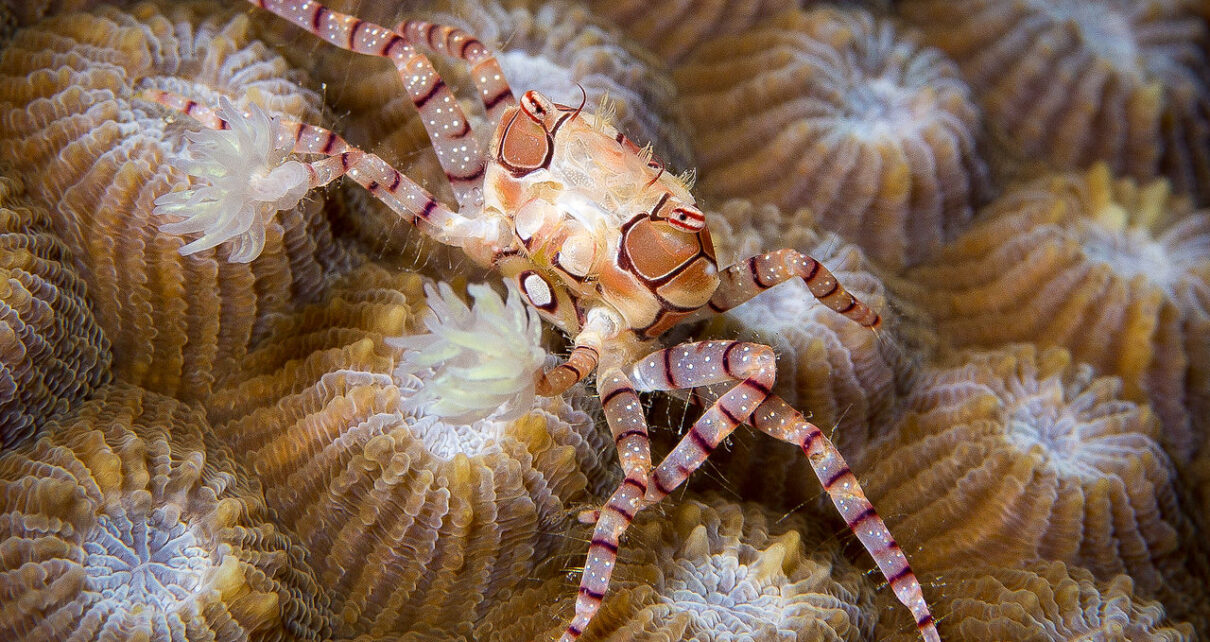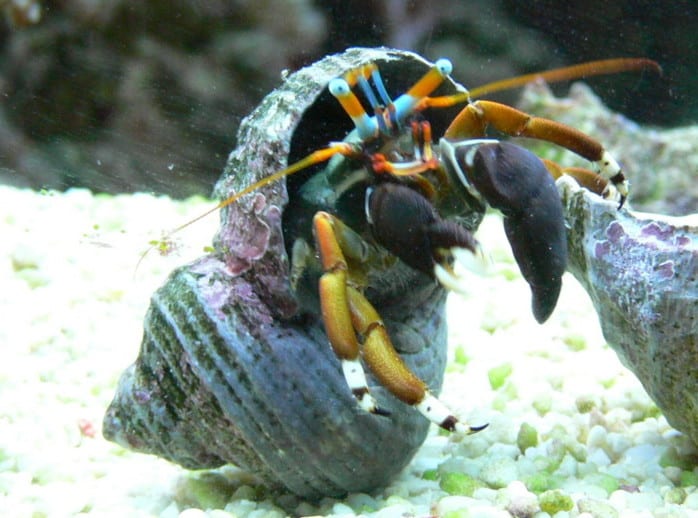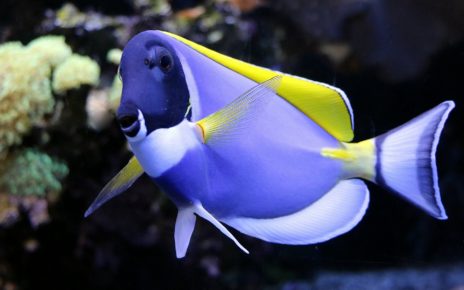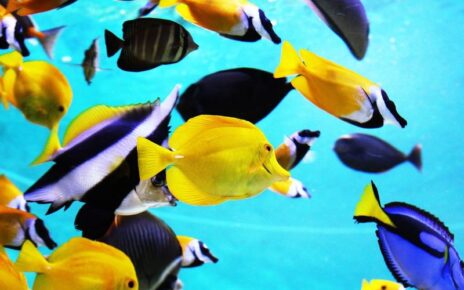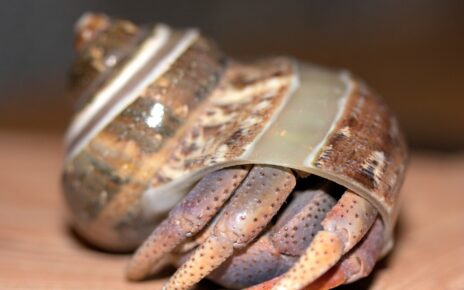Reef safe crabs play an important role in the health and longevity of a reef tank. Crabs are a natural part of a reef ecosystem since they help control algae, and they also consume uneaten food and debris from a sand substrate. Some crabs will even help control a cyanobacteria bloom before it takes over your tank.
However, if you add a non-reef safe crab to a reef tank they can quickly destroy your expensive corals, and some crabs will even kill fish and other invertebrates in your tank.
That’s why we put together this list of reef safe crabs, so you can quickly find the best crab for a reef tank.
Reef Safe Crabs
Blue Leg Hermit Crab (Clibanarius tricolor)
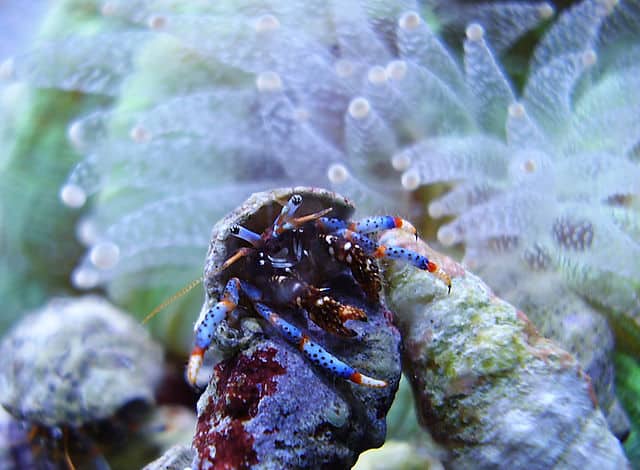
The Blue Leg Hermit Crab (Buy Online) has bright blue legs with red bands near each joint. They also have bright blue eye stalks and blue mouth parts that protrude from their shell. These brightly colored crabs also have a great personality, and they are a perfect fit for a peaceful community tank.
Blue Leg Hermit Crabs will grow to be about 1-inch long when they reach adulthood. It’s recommended that you keep a Blue Leg Hermit Crab in at least a 20 to 30-gallon tank (Buy Online) with plenty of shells for them to move into as they grow.
Blue Leg Hermit Crabs constantly scavenge a tank for leftover food and detritus to eat. They are also voracious algae-eaters, and they tend to leave hard coral and soft coral alone, which makes them one of the best reef safe crabs to keep for beginners.
Red Leg Cortez Hermit Crab (Clibanarius sp.)

The Red Leg Hermit Crab (Buy Online) has a vibrant red coloration that really stands out against a white sand substrate.
Red Leg Cortez Hermit Crabs are an active and outgoing crab that does well in a peaceful community tank. They will grow to a maximum size of around 1-inch long, and they will do best when kept in at least a 20 to 30-gallon tank.
Red Leg Hermit Crabs will scavenge for leftover bits of food like most hermit crabs, and they love to eat multiple types of algae.
Red Leg Cortez Hermit Crabs are also known as grazer hermit crabs, and they have a strong dietary preference for green hair algae and cyanobacteria. They also tend to leave coral alone which makes them one of the best reef safe crabs for a small to medium-sized reef tank.
Emerald Crab – Mithrax sculptus
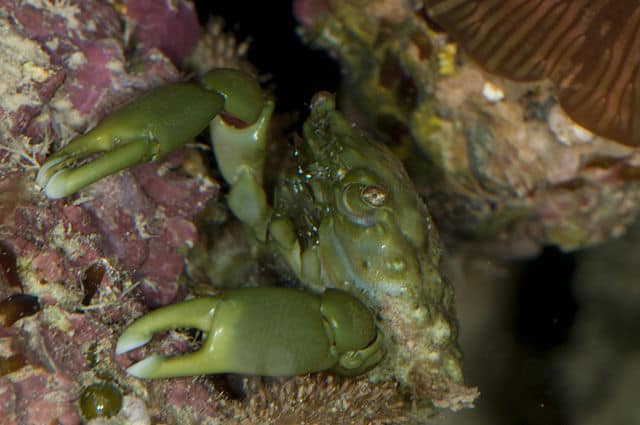
The Emerald Crab (Buy Online) is a very popular reef safe crab species that are great at controlling algae. They do best in a saltwater tank with lots of live rock and a live sand substrate.
Emerald Crabs are one of the most voracious algae-eating crabs you can keep in a reef tank, and they make a great addition to any cleanup crew. They are also especially effective at controlling bubble algae that most other crabs won’t eat.
Emerald Crabs can become aggressive if they don’t have enough algae to eat. If there isn’t enough algae in your tank you can feed them seaweed and meaty foods on a regular basis to control their aggression.
Emerald Crabs do well in peaceful community tanks, and they tend to leave coral alone, and they won’t harass their fellow tank mates as long as they have enough to eat. They also don’t grow that large so they can be kept in almost any size reef tank.
Arrow Crab – Stenorhynchus seticornis
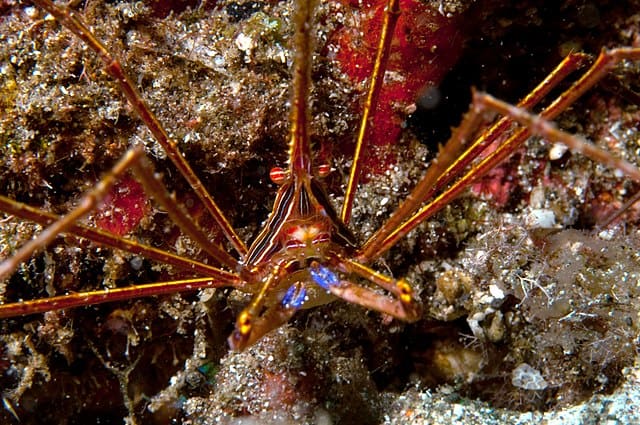
The Arrow Crab (Buy Online) has a head and body that looks a little like an arrow hence its name. It has very long spider-like legs, and the males tend to be bigger than female members of the species.
The Arrow Crab can be aggressive with members of their own species or other shrimp and crabs that have a similar morphology. That’s why it’s advised that you only keep a single Arrow Crab in a reef tank to avoid conflicts. They also grow up to six inches wide and they need to be kept in a larger tank.
The Arrow Crab can crawl very quickly thanks to their long legs, which they use to their advantage to attack slower moving prey. They have been known to attack other crustaceans like Banded Coral Shrimp, and they will even try to eat small slow-moving fish. However, they tend to leave coral alone so they are a reef safe crab, but you just need to be aware that you need to keep them with compatible tank mates.
Boxing Crab – Lybia tessellata
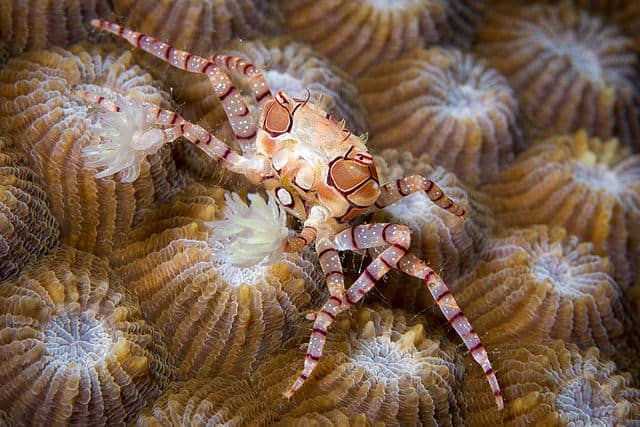
The Boxing Crab (Buy Online) is also known as the Pom Pom Crab, and it is one of the most interesting crabs that you can add to a reef tank. These crabs also remain small throughout their lives, which makes them a perfect fit for a nano tank.
Pom Pom Crabs are very peaceful crabs that won’t harm any of their fellow tank mates. However, they are pretty small, so they shouldn’t be housed with larger fish or other predatory inverts.
The Boxing Crab gets its name from the two small anemones it carries around like boxing gloves in both of its front claws for protection from predators. The anemones also act as a filter that the crab waves around to catch bits of food floating in the water column.
The Boxing crab then picks the larger food particles off the anemone, and the anemone also benefits from the relationship since it gets to eat the bits of food that are too small for the crab to eat
The Boxing Crab is reef safe since it prefers to use the anemones to filter feed, so they won’t get the urge to pick at corals like most crabs do when they get hungry.
Anemone Crab – Neopetrolisthes maculatus
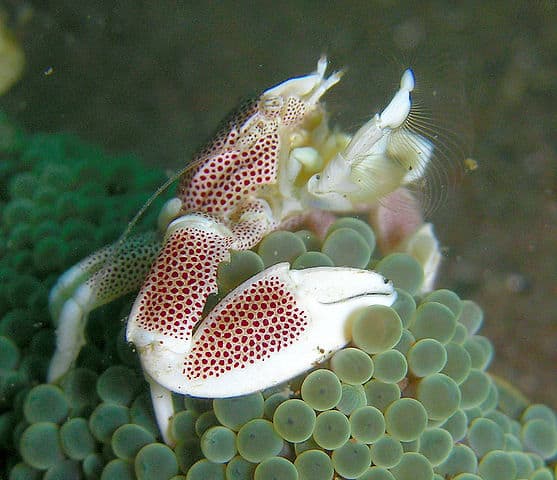
The Anemone Crab (Buy Online) has a bright white body that’s speckled with reddish-purple spots. They are a peaceful reef safe crab that gets along with a wide variety of tank mates.
Anemone Crabs are very easy to care for and they will help keep your reef tank clean since they love to graze on algae and scavenge for detritus.
In some cases, Anemone Crabs will pair up with an anemone and form a symbiotic relationship. In order for this to occur they need to be kept in a well-established reef tank with plenty of food for both the anemone and the crab to eat.
Anemone Crabs can be aggressive toward other invertebrates and they can be territorial. It’s a good idea to keep them in at least a 30-gallon tank with lots of live rock that has plenty of crevices that offer territory for them to claim.
Horseshoe Crab – Limulus polyphemus
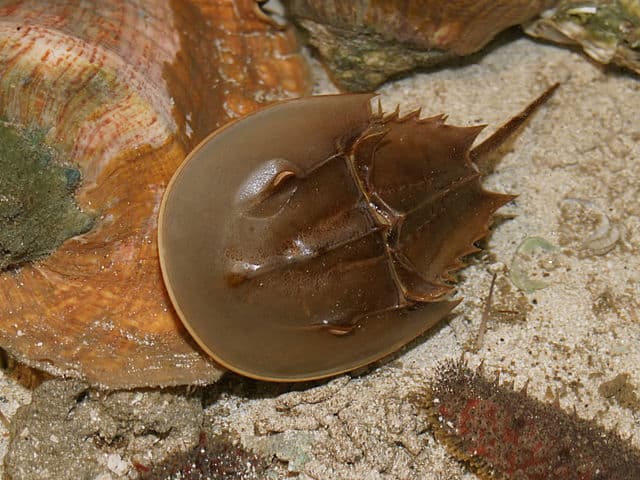
The Horseshoe Crab (Buy Online) is one of the most unique invertebrates that you can add to a reef tank. They are one of the oldest species currently living on the planet and they have survived numerous mass extinctions, which makes them one of the most bulletproof invertebrates you can keep.
Horseshoe Crabs aren’t actually crabs instead they are more closely related to spiders and scorpions. They also have blue blood which uses copper based hemocyanin to carry oxygen instead of iron-based hemoglobin. Their blood is also used in medical research to test for contamination since it immediately clots and encapsulates any foreign material as a way to protect against bacterial infections and disease.
Horseshoe Crabs like to be kept in a reef tank with a deep sand bed since they like to burrow for food and to find a safe place to sleep. This makes them one of the best sand aerators since they can turn over a lot of sand with their powerful legs and shovel-like bodies.
Horseshoe Crabs primarily feed on algae, worms, and other large meaty bits of food on the substrate. When they are young they completely reef safe, but as they get larger they might cause problems if they are kept in a small densely stocked reef tank.
Orange Leg Hermit Crab – Ciliopagurus strigatus
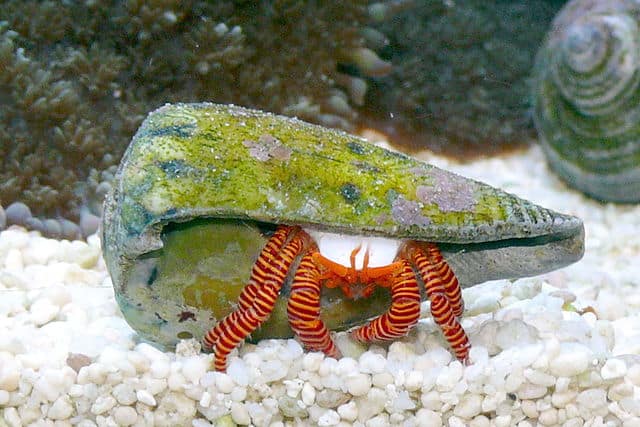
The Orange Leg Hermit Crab (Buy Online) also goes by the more festive name Halloween Hermit Crab. It is one of the most striking hermit crabs with bright orange legs with dark red stripes spanning the full length of their legs.
The Halloween Hermit Crab is native to the waters of the Indo-Pacific and it’s primarily found off the shores of Hawaii. They also get larger than other hermit crabs, and you can expect that they will reach a maximum adult size of two inches.
Halloween Hermit Crabs also tend to be more aggressive than other hermit crabs, so care should be taken when selecting compatible tank mates. To keep aggression to a minimum Orange Leg Hermit Crabs should be fed meaty foods especially when there isn’t enough algae and other food for them to eat.
Zebra Reef Hermit Crab – Calcinus laevimanus
The Hawaiian Zebra Hermit Crab (Buy Online) is also known as the Left-Handed Hermit Crab. They have large black and white banded claws with a larger left claw hence the name.
Left Handed Hermit Crabs are reef safe algae-eaters, and they will help aerate the sand bed in a reef tank in their search for detritus to eat. They are also very peaceful crabs, and they don’t grow to a large size, so they can be kept in almost any size aquarium even a 5-gallon tank (Buy Online).
Electric Blue Hermit Crab – Calcinus elegans
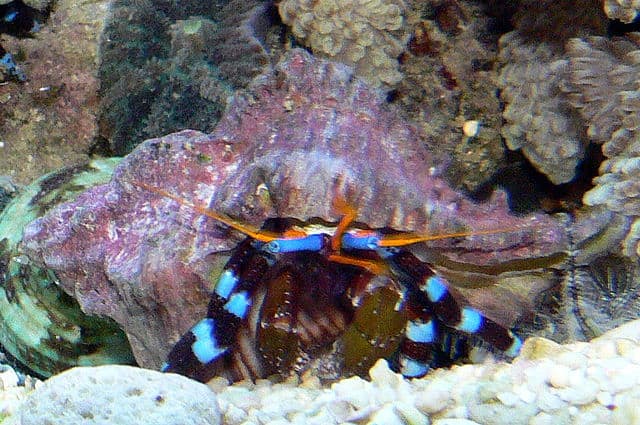
The Electric Blue Hermit Crab (Buy Online), is a dwarf hermit crab with tiny bright blue legs. They make a great addition to any cleanup crew, and they are very easy to keep. They are also very peaceful, and they are completely reef safe.
They do a great job of removing algae from live rock since they can easily get into tight spaces. Also, they will help keep the substrate clean in a reef tank since they will quickly clean up any uneaten food and debris.
Blue Eye Hermit Crab – Paguristes sericeus
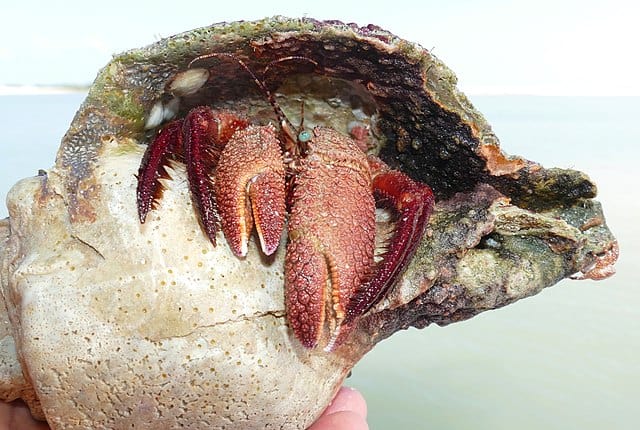
The Blue Eye Hermit Crab (Buy Online) is an interesting hermit crab that has bright blue eyes juxtaposed against a light pink body. They are also relatively rare since they are only naturally found in a small habitat off the shores of the Marshall Islands.
The Blue-Eyed Hermit Crab is reef safe, and it gets along well with other fish and invertebrates when kept in a peaceful community tank. They do a great job of eating algae, and they will also help turn over a sand substrate in a reef tank.
Trapezia Pocillopora/Acropora Crab
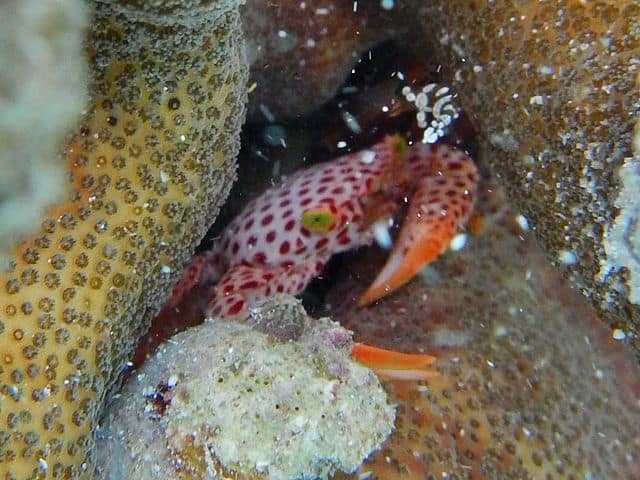
The Acropora Crab (Buy Online) is a special little crab that has evolved to live in hard coral for its whole life. They prefer to live in Pocillopora corals, but they will accept Acropora Corals if there are no Pocilloporid present in their environment.
The Acropora Crab helps maintain coral health in a reef tank by keeping the many branches of an Acropora coral clean and free of debris. This helps increase the water flow between the branches, and as we all know Acropora corals need a strong current to thrive in a reef tank.
The Acropora Crab primarily feeds off trapped food particles and debris that get lodged in the coral. But they have also been observed feeding on the mucus secreted by their host coral when they get hungry.
The coral also gets other benefits besides the cleaning service since the crabs will protect the coral from predators, and they will eat some invasive coral pests as well.
In the past, Acropora Crabs were considered a “pest” but they have proven to be beneficial members of a healthy reef community. It has also been noted that corals hosting Acropora Crabs have higher survival rates and stronger growth than corals that are Acropora crab free.
The Acropora Crab should only be added to an established reef tank with well developed Acropora corals. If they don’t form a commensal relationship with a mature Acropora coral they’ll have a hard time surviving in a reef tank.
Red Leg Hermit Crab – (Clibanarius diguetti)

The Red Leg Hermit Crab (Buy Online) has a subdued red color with light red pinkish legs. They have the same great personality as most of the other hermit crabs on this list, and they are very outgoing so they won’t stay hidden all day.
Red Leg Hermit Crabs constantly scavenge for food and while doing so they help turnover and aerate stagnant sand substrates. They also eat many different algae species, and they can even help control cyanobacteria outbreaks.
Strawberry Crab – Liomera sp
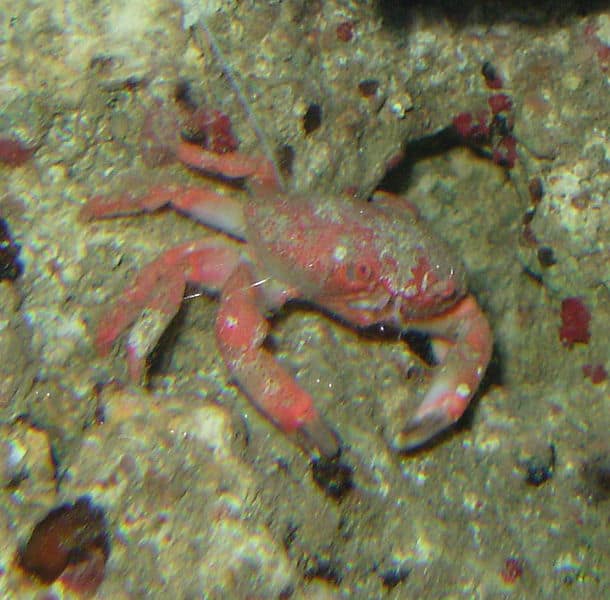
The Strawberry Crab (Buy Online) also goes by the name Red Boxing Crab, and it hails from the beautiful blue waters off the coast of Hawaii. They have a bright pink shell that’s covered in tiny white spots, and they have large front claws that are specially adapted to pick algae off rocks.
Strawberry Crabs do well in aquariums with plenty of live rock for them to pick at and scavenge algae, and they also like to hide in crevices to feel safe. They tend to get along well with most fish, and they will tolerate most invertebrates
They will eat a wide range of food including meat so they do a good job of cleaning uneaten food off the bottom of a reef tank, But they are primarily herbivorous, so if your tank doesn’t have enough algae you might have to supplement their diet with seaweed.
Sally Lightfoot Crab – Percnon gibbesi
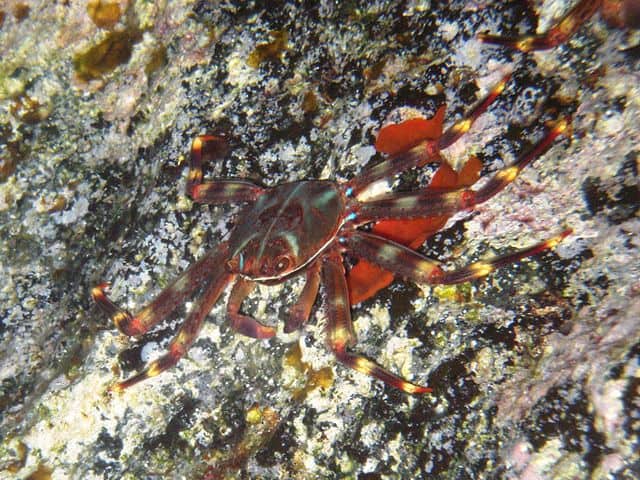
The Sally Lightfoot Crab (Buy Online) is a unique crab the goes by many names. It’s sometimes called the Nimble Spray, Short, or Urchin Crab, and it has a brown shell with yellow and orange bands on its legs.
The Sally Lightfoot Crab is descended from shore crabs, but it primarily lives in the sea, so it can live on land for short periods, but there is little risk that it will try to escape from a reef tank.
The Sally Lightfoot Crab has evolved to hide in tight crevices since they have a flat carapace, and they can be hard to spot when they find a hiding place.
The Sally Lightfoot Crab needs to be kept in a tank with a strong current, and of course, they need lots of live rock to take refuge in and to scavenge for debris. They will eat small amounts of algae but they primarily eat detritus that builds up in the rock work.
The Sally Lightfoot Crab can become aggressive when they get older, and they have been known to eat small fish. For this reason, they should only be kept in reef tanks with large fish and other similarly sized invertebrates that can effectively defend their territory.

